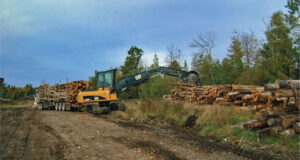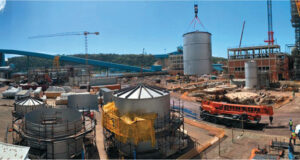KENNETH R. GILBREATH
For Verso Corp., sustainability and efficiency are literally at the center of things: the company’s six core values include “Manufacturing Efficiency” at #3 and “Citizenship and Stewardship” at #4. With reduced energy use at the nexus of those core values, it seems natural that identifying opportunities to do so was an attractive prospect for Verso leaders. In 2016, an energy audit provided the information the company needed to move forward.

Verso’s Wisconsin Rapids mill.
Paper360° spoke with Verso’s Steve Brooks, director, corporate energy, as part of a 2018 feature on energy use (see “Accessing Innovation: Partnering for Energy Projects” in the July/August 2018 issue of Paper360°). “Last year we significantly changed the energy footprint of our pulp mill through a reconfiguration that resulted in the shutdown of obsolete equipment, providing both maintenance and energy cost savings,” Brooks said then. “This year, we are moving forward with a list of energy projects that will save thousands of pounds of steam every hour.” This update article takes a deeper dive into the energy audit process that made that possible.
THE AUDIT PROCESS
With reported net sales at US$2.7 billion, Verso is a leading North American producer of specialty and graphic papers, packaging, and pulp. The company has headquarters in Miamisburg, OH, with a Technical Center in Biron, WI, as well as seven pulp and paper mills and a network of distribution centers and warehouses strategically located across the country.
A Focus on Energy-funded Pulp Mill Energy Audit was conducted in September 2016 at Verso’s Wisconsin Rapids integrated pulp and paper mill. Focus on Energy is Wisconsin utilities’ statewide energy efficiency and renewable resource program, funded by the state’s investor-owned energy utilities and participating municipal and electric cooperative utilities.
The mill conducted a Monday morning kick-off meeting with all operating departments to review the audit process, establish priorities, and identify informational requirements. The energy audit included all process areas (pulp mill, lime kiln/caustic plant, bleach plants, boiler feed water make-up, evaporators, paper machines, etc.) where direct or indirect steam was used to heat stock and/or water. This included warm water tanks, hot water tanks, silos/wire pits, bleach plant steam mixers, steam stripping columns, shower water, and hot water heaters.
Process areas were benchmarked against other mills where waste heat was optimized to minimize process steam heat. The audit process developed high return projects to optimize (reconfigure) existing waste heat recovery systems to reduce process steam, maximize hot water and stock temperature, reduce process water usage, and prevent negative impacts on waste water treatment during summer and winter operating conditions.

Information requested from the mill included:
• Incremental steam cost (low and medium pressure) of fuel being displaced—US$/1,000 lb.
• Incremental power generation cost of fuel being displaced and purchased power—US$/kWh.
• Boiler feedwater make-up treatment costs—US$/1,000 gal.
• Specification sheets for existing major heat exchangers (HEX) and condensers including surface area, flows and temperatures on both sides, tube diameter or plate gap. Required HEX and condensers include flash steam condensers, black liquor coolers, cold blow coolers, green liquor cooler/heater, turpentine condensers, blow heat primary and secondary condenser, blow heat hot water HEXs, ClO2 HEXs, effluent HEXs, stripper feed HEXs, primary and secondary reflux condensers, etc. (inclusive list for any mill).
• DCS Screenshots, Aspen or PI Processbooks of major process areas (identified during mill process area tours).
• Summer and winter operating data for the requested process areas.
During the audit week, flows and temperatures of all process area HEXs and condensers were measured with portable calibrated equipment and compared to actual operating data. The audit team made additional measurements of bleach plant and brown stock washer shower flows, repulper dilution flows, wire cleaning and water doctor flows, and tempered, warm, and hot water tank flows. All of this information was used to develop validated summer and winter Base Case water and energy balances for the mill. In addition, detailed pulp mill, bleach plant, hot water, and tempered water process area balances were developed.
“We greatly appreciate the Focus on Energy experts’ hands-on approach to gathering data, verifying the actual process, taking field measurements, and developing energy balances to help us identify and prioritize opportunities,” says Mark Snyder, senior process engineer. “Their familiarity and experience with the process has resulted in tremendous savings.”
LOW-HANGING FRUIT
During the audit week, the team identified several non-capital or minimum capital project opportunities. These included the following:
• A cold-water line was inadvertently left in the shutdown mode and sending cold water to a paper machine hot water tank.
• A leaking by-pass valve was sending high temperature condensate from the Heavy Black Liquor Oxidation (HBLOX) vent condenser to a secondary HEX. The high temperature waste heat was going to the raw water supply system instead of the hot water system.
• Excessive seal water flow was flowing into a black liquor pump, diluting black liquor to the evaporators.
• A significant error was found in the No. 1 Evaporator surface condenser cooling water flow meter (measured flow was 1,900 gpm lower than the flow meter).
HIGH-RETURN PROJECTS
After verification of the Base Case summer and winter balances, a detailed list of high return projects was developed and presented in the Final Audit Report. The report included detailed water and energy balances for the identified projects; estimated project costs; steam, power, and water savings for summer and winter operating conditions; and simple project returns.
Each project was evaluated independently and presented in a recommended project implementation sequence to prevent double counting of energy savings. The identified projects with brief description, annualized energy savings, and estimated installed cost included the following:
• ClO2 HEX—The project consisted of an all-titanium welded plate and frame HEX designed to heat ClO2 from 55 to 125°F for both bleach plants. The recommended heat source was D1 stage washer filtrate from the hardwood bleach plant. The HEX was sized based on future operating conditions after a hot water reconfigure project for both bleach plants. This prevents over-sizing the HEX and maximizes future energy savings. The audit team identified annual steam savings of 14.7 klb/hr; this steam would have a projected capital cost of almost US$900,000. The project return was low compared to the other projects and will be re-evaluated for future implementation (2020 or later).
• Washer Wire Cleaning Shower Timers—The measured hot water flow to the wire cleaning showers and water doctors at the brown stock deckers and bleach plant washers was excessive. The energy experts estimated that a simple project to install on-off timers to reduce the flow and save steam at the evaporator and bleach plant hot water heater could save 7.2 klb/hr of steam with a projected cost of US$180,000 thousand. This project has been implemented with incentive funding from Focus on Energy.
• Softwood Digester Flash Steam Condenser—The existing flash steam condenser on the softwood continuous digester was undersized and sending a large volume of very low temperature hot water to a continuously overflowing mill hot water tank. The team evaluated two project options. The first option consisted of installing a new primary condenser with the existing condenser used as a secondary condenser. The cooling water source would be changed from unheated filter water to tempered water with countercurrent flow from the existing condenser to the new primary condenser. This would substantially increase the hot water tank temperature and save steam at the bleach plant/caustic plant hot water heater.
The second option was to use the flash steam in the digester steaming vessel (original digester design and piping) and save live steam at the steaming vessel. The mill implemented this second option, with a net annual steam savings of 27.5 klb/hr. The net savings includes the impact of eliminating the waste heat from the existing condenser to the hot water tank.
• Reconfigure No. 1 and No. 2 Evaporator Surface Condensers—The existing operating strategy sends warm cooling water from No. 2 Evaporator surface condenser to the tempered water tank during the summer months with warm water from No. 1 Evaporator surface condenser going to the non-contact sewer outfall. During the winter months, both condensers send very cool warm water to the tempered water tank. The reconfiguration project changed summer operation to send warm water from No. 1 Evaporator surface condenser to the tempered water tank. The actual measured flow from No. 1 Evaporator surface condenser at 109°F matched mill tempered water demand and saves substantial steam during the summer months at the bleach plant/caustic plant hot water heater. The reconfiguration project piped No. 2 Evaporator surface condenser cooling water to the inlet of No. 1 Evaporator surface condenser for series operation during the remainder of the year. This reduced mill filtered water use by about 2,730 gpm, increased the tempered water temperature, and saved substantial steam at the bleach plant/caustic plant hot water heater. This project was implemented in 2018 with an annual steam savings of 34.8 klb/hr with a US$700,000 capital cost.
• Hot Water Reconfiguration—The existing HBLOX system is the only high temperature heat source supplying hot water to the mill’s hot water tank. It consists of a packed bed direct contact vent condenser removing heat from the oxidized heavy black liquor. The high temperature condensate from the vent condenser goes to a primary HEX where filtered water removes a large portion of the heat. The hot water from the primary HEX goes to the hot water tank. A second HEX operates in series with the primary HEX, further removing heat from the circulated vent condenser condensate. The secondary HEX uses raw water as the cooling water source and provides heat to the mill raw water supply.
• Both the primary and secondary HEXs are oversized, with cooling water flow rates operating in a range of 15 to 45 percent of the design flow. The hot water reconfiguration project pipes warm water (135 to 145 °F temperature range) from the pre-evaporator surface condenser as the cooling water source to the HBLOX primary HEX. The warm water flow would be fixed at a rate slightly above the primary HEX design flow. This maximizes the HEX U-Factor, HEX scouring velocity and the volume and temperature of hot water produced. The large volume of high temperature hot water from primary HEX would be diverted to the suction of hot water pump at the Hot Water Tank that supplies water to the bleach plant/caustic plant hot water heater. Additional warm water from the pre-evaporator surface condenser would also be directly connected to the existing pipe line supplying hot water to the paper mill. This eliminates large swings in volume and temperature of hot water to the paper machines. Excess cooling water from the pre-evaporator surface condenser would continue to flow to the hot water tank. The annual steam savings is estimated at 28.3 klb/hr with a projected capital cost of US$900,000. The project will be re-evaluated for future implementation (2020 or later).
• Boiler Feedwater Make-up HEX—This project reuses three out-of-service spiral bleach plant effluent HEXs operated in series to heat boiler feedwater (BFW) make-up. The softwood bleach plant EOP washer filtrate would be the heat source. The annual steam savings is estimated at 11.4 klb/hr with a projected capital cost of US$480,000. The project will be re-evaluated for future implementation (2020 or later).
The total combined impact of these projects is an estimated annual steam savings of 124.8 klb/hr with a capital cost value of US$3.14 million. The mill is implementing these projects in phases, with partial funding from incentives provided by Focus on Energy.
Verso mill personnel feel that the Focus on Energy program is crucial to developing and implementing energy savings projects in Wisconsin. “Focus on Energy is a wonderful partner to the paper industry. Their experts have helped us identify and complete highly successful energy savings initiatives in our pulp mill,” says Gary Hegewald, technical services manager. “We look forward to bringing their paper machine subject matter experts in later this year to help us identify additional savings opportunities.”
Kenneth R. Gilbreath is a subject matter expert in pulping with the Focus on Energy Program. Gilbreath has worked in the pulp and paper industry for more than 45 years in various technical, manufacturing, engineering, and consulting positions; the past 16 years have focused on energy conservation and waste heat recovery. Reach him at [email protected].
 Paper 360
Paper 360


